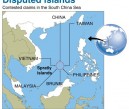Philippines, US to set up South China Sea defense line
3597
A+
A
A-
The Philippines and the United States are putting up a defensive line meant to prevent China from punching through to the Pacific and threatening American military real estate in Guam, analysts say.
The US will be able to use at least eight military bases in the Philippines where it can rotate its troops, planes and ships, under a 10-year defense pact signed in April last year.
Two of these bases will give the US rapid access to the Spratly archipelago in the South China Sea, where China is digging in with a chain of island-fortresses.
The other bases are listening posts and staging areas for the US to monitor and limit China’s movements.
Plans are being drawn up in Washington to directly contest – with warships and aircraft – Beijing’s territorial claims to nearly all of the South China Sea, and deter China’s military from crossing to the Pacific, analysts say.
China has created over 800ha of land since last year on seven reefs in the Spratlys in the South China Sea, parts of which are also claimed by the Philippines, Vietnam, Brunei, Taiwan and Malaysia.
“The Americans know they are the ultimate goal here. Once the Chinese consolidate in the Spratlys and they punch through, then they’ll go to the second island chain: Guam,” Jose Custodio, a consultant of the Philippine military and a former adviser to a US defense company working for the US Pacific Command, told The Straits Times.
Guam is the home port of a US submarine squadron and a strategic base of the US Seventh Fleet operating in the Pacific.
A strategy paper released on Tuesday by China alludes to the US as its opponent, as it blasts “some external countries” that are “meddling in South China Sea affairs”.
The US used to have permanent bases in the Philippines.
One was in Subic Bay north of the capital Manila, the largest outside the US with an area of 678 sq km – about the size of Singapore.
In 1992, a nationalist Senate voted to evict these bases.
Subic has since been transformed into an economic zone, but American naval ships continue to make port calls there.
Another former US base, Clark, is now a civilian airport, but still serves as a staging area for US surveillance operations.
An American P8-A Poseidon plane – which the Chinese military recently warned off at least eight times as it swooped over a China-held reef in the Spratlys – reportedly took off from Clark.
Defense Secretary Voltaire Gazmin said evicting the US bases had been a mistake. “If the Americans had not left, we wouldn’t be in this predicament,” he said China would never have been able to go near Scarborough shoal off the coast of the Philippine province of Zambales had the Americans remained in Subic, he said.
The Americans were using Scarborough as an “impact range” at the time, he pointed out.
Since 2012, after a tense naval standoff with the Philippines, China has set up a blockade around Scarborough, keeping away Filipino fishermen who depended on the shoal’s lagoon for a living.
Custodio said once the Chinese islands in the Spratlys are operational and as the US settles in, something similar to the Bar Lev Line will emerge in the South China Sea.
Israel had built that chain of fortifications along the eastern coast of the Suez Canal after it captured the Sinai Peninsula from Egypt in the 1967 Six-Day War.
“It will be like a tripwire: Once one side crosses, all hell will break loose,” said Custodio.
RELATED VIDEOS
Read more: http://globalnation.inquirer.net/123749/philippines-us-to-set-up-south-china-sea-defense-line#ixzz3blMusyRF
Follow us: @inquirerdotnet on Twitter | inquirerdotnet on Facebook




No comments:
Post a Comment